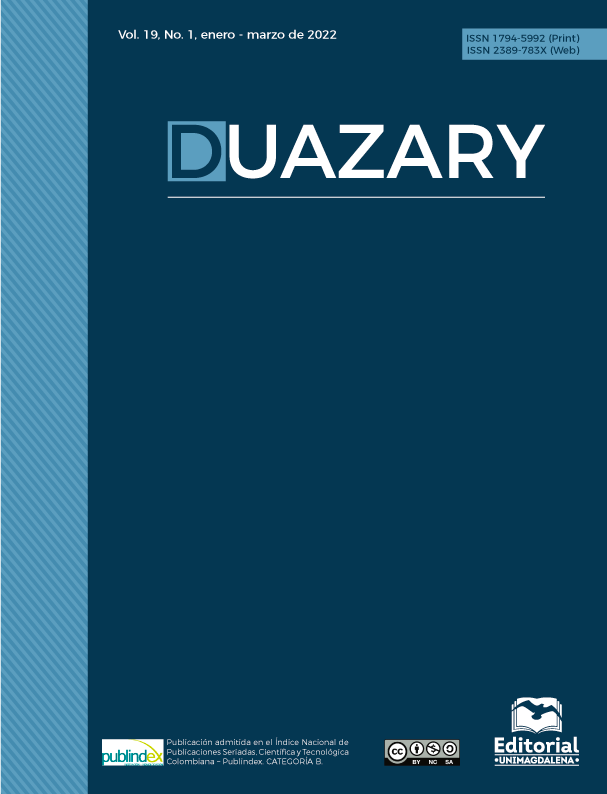Shock and modified shock index in the immediate puerperium
Main Article Content
Abstract
The parameters that define shock (tachycardia, hypotension and poor perfusion of the end organ) are not fully applicable to the obstetric patient due to the physiological changes that make it difficult to establish cut-off to trigger clinical interventions; but a relationship of them can generate a more accurate indicator of hypovolemia called the shock index (SI) and modified shock index (ISM). A cross-sectional study was carried out aimed to establish the median of the shock index and Modified Shock Index, standard deviation and the CI [95%] at 30 minutes, at one hour and two hours. The values at the different moments were compared with an ANOVA test and according to the route of delivery using Wilcoxon Ranges. Spearman's correlation coefficients were calculated between the modified shock index and age of the patients and gestational age. The medians of the Shock Index and Modified Shock Index were 0.669 SD: 0.014 CI [95%]: 0.664 - 0.692 and 0.922 SD: 0.019 CI [95%]: 0.914 - 0949 respectively. There is no correlation of these values with the ages of the patients or gestational age.
Downloads
Article Details

This work is licensed under a Creative Commons Attribution-NonCommercial-ShareAlike 4.0 International License.
References
DeMuro JP, Simmons S, Jax J, Gianelli SM. Application of the shock index to the prediction of need for hemostasis intervention. Am J Emerg Med. 2013; 31(8): 1260-3. Doi: http://dx.doi /10.1016/j.ajem.2013.05.027
Schroll R, Swift D, Tatum D, Couch S, Heaney JB, Llado-Farrulla M, et al. Accuracy of shock index versus ABC score to predict need for massive transfusion in trauma patients. Injury, Int J Care Injured. 2018; 49: 15-9. Doi: https://doi.org/10.1016/j.injury.2017.09.015
Lyon M, Blaivas M, Brannam L. Sonographic measurement of the inferior vena cava as a marker of blood loss. Am J Emerg Med 2005; 23(1): 45-50. Doi: https://doi.org/10.1016/j.ajem.2004.01.004
Guerrero-De León MC, Escárcega-Ramos LR, González-Días OA, Palomares- Leal A, Gutiérrez-Aguirre CH. Utilidad del índice de choque como valor predictivo para el requerimiento de trasfusión en hemorragia obstétrica. Ginecol Obstet Méx. 2018; 86(10): 665-74. Doi: http://dx.doi /10.24245/gom.v86i10.2346
Terceros-Almanza LJ, García-Fuentes C, Bermejo-Aznárez S, Prieto-del Portillo IJ, Mudarra-Reche C, Sáez-de la Fuente I, et al. Predicción de hemorragia masiva. Índice de shock e índice de shock modificado. Med Intensiva. 2017; 41(9): 532-8. Doi: http://dx.doi 10.1016/j.medin.2016.10.016
Borovac-Pinheiro A, Pacagnella RC, Cecatti JG, Miller S, El Ayadi AM, Souza JP, et al. Postpartum hemorrhage: New insights for definition and diagnosis. Am J Obstet Gynecol. 2018; 219(2): 162-8. Doi: https://doi.org/10.1016/j.ajog.2018.04.013
Witting MD. Standing shock index: An alternative to orthostatic vital signs. Am J Emergency Med. 2017; 35(4): 637-9. Doi: http://dx.doi /10.1016/j.ajem.2016.12.052
Vousden N, Nathan HL, Shennan AH. Innovations in vital signs measurement for the detection of hypertension and shock in pregnancy. Reproductive Health. 2018; 15(Suppl 1): 89-91. Doi: http://dx.doi /10.1186/s12978-018-0533-4
Chung J-Y, Hsu, Ch-Ch, Chen J, Chen W-L, Lin H-J, et al. Shock index predicted mortality in geriatric patients with influenza in the emergency department. Am J Emergency Med. 2018. Doi: https://doi.org/10.1016/j.ajem.2018.05.059
Kristensen AK, Holler JG, Hallas J, Lassen A, Shapiro N. Is the shock index a universal predictor in the emergency department? A cohort study. Critical Care. 2015; 19(Suppl 1): P148. Doi: http://dx.doi 10.1186/cc14081
Tseng J, Nugent K. Utility of the Shock Index in Patients with Sepsis. Am J Med Sci 2015; 349(6): 531-5. Doi: https://doi.org/10.1097/MAJ.0000000000000444
Eppes CS, Schupp J, Dildy D. Shock Index: A potential criterion for a maternal early warning system. Am J Obstet Gynecoog. 2016; (January): S159. Doi: https://doi.org/10.1016/j.ajog.2015.10.311
Pacagnella RC, Souza JP, Durocher J, Perel P, Blum J, Winiko B, et al. A Systematic Review of the Relationship between Blood loss and Clinical Signs. PLOS ONE. 2013; 8(6): e57594. Doi: http://dx.doi:10.1371/journal.pone.0057594
Jaramillo S, Barnhart K, Takacs P. Use of the shock index to predict ruptured ectopic pregnancies. Int J Gynaecol Obstet. 2011; 12(81): 68. Doi: http://dx.doi/10.1016/j.ijgo.2010.08.005
Guzmán-Polanía L, Paternina-Caicedo A, Tolosa JE, Rojas-Suárez J. Descripción del índice de choque en el embarazo [Tesis de grado. Especialista en Ginecología y Obstetricia]. Cartagena: Universidad de Cartagena. Facultad de Medicina; 2013.
Liu Y, Liu J, Fang Z, Shan G, Xu J, Qi Z, et al. Modified shock index and mortality rate of emergency patients. World J Emerg Med 2012; 3(2): 114-7. Doi: http://dx.doi/10.5847/wjem.j.issn.1920-8642.2012.02.006
Guyton A, Hall H. Tratado de fisiología médica. 13 edición. Barcelona, España: Elsevier; 2016.
Sharma A, Satish U, Tevatia MS, Singh SK. Prehospital shock index, modified shock index, and pulse pressure heart rate ratio as predictors of massive blood transfusions in modern warfare injuries: A retrospective analisis. Med J Armed Forces India. 2019; 75: 171-5. Doi: https://doi.org/10.1016/j.mjafi.2018.07.002
Strehlow MC. Early identification of shock in critically ill patients. Emerg Med Clin N Am 2010; 28: 57-66. Doi: http://dx.doi: 10.1016/j.emc.2009.09.006
Birkhahn RH, Gaeta TJ, Bei R, Bove JJ. Shock index in the first trimester of pregnancy and its relationship to ruptured ectopic pregnancy. Academic Emergency Medicine 2002; 9: 115-9. Doi: https://doi.org/10.1197/aemj.9.2.115
Nathan L, Cottam K, Hezelgrave NL, Seed PT, Briley A, Bewley S, et al. Determination of Normal Ranges of Shock Index and Other Haemodynamic Variables in the Immediate Postpartum Period: A Cohort Study. PLOS ONE. 2016; 11(12): e0168535 Doi: http://dx.doi /10.1371/journal.pone.0168535
Le Bas A, Chandraharan E, Addei A, Arulkumaran S. Use of the “obstetric shock index” as an adjunct in identifying significant blood loss in patients with massive postpartum hemorrhage. Int J Gynecol Obstet. 2014; 124: 253-5. Doi: https://doi.org/10.1016/j.ijgo.2013.08.020

